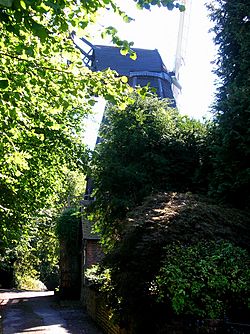Meeten's Mill, West Chiltington facts for kids
Quick facts for kids West Chiltington Windmill |
|
|---|---|

The mill in 2006
|
|
| Origin | |
| Mill name | Meeten's Mill |
| Mill location | TQ 085 181 |
| Coordinates | 50°57′07″N 0°27′25″W / 50.952°N 0.457°W |
| Operator(s) | Private |
| Year built | 1838 |
| Information | |
| Purpose | Corn mill |
| Type | Smock mill |
| Storeys | Two-storey smock |
| Base storeys | Two-storey base |
| Smock sides | Eight sides |
| No. of sails | Four |
| Type of sails | Spring sails |
| Winding | Fantail |
| No. of pairs of millstones | Three pairs |
Meeten's Mill is a special type of windmill called a smock mill. It is located in West Chiltington, Sussex, England. This old mill is now a home, but it used to grind corn into flour. It is also a "grade II listed" building, which means it's an important historical site.
Contents
History of Meeten's Mill
How the Mill Was Built and Moved
Meeten's Mill wasn't always in West Chiltington. It was first built in a place called Monkmead. In 1838, the entire mill was carefully moved to its current spot in West Chiltington. This was a big job!
Early Records and Upgrades
The mill first appeared on a local map, called a tithe map, in 1840. This map showed who owned land and what was on it. Later, in 1865, a mill builder named William Cooper from Henfield made some important upgrades to the mill.
When the Mill Stopped Working
Meeten's Mill continued to grind corn for many years. It worked until 1922. After that, its machinery was taken out, and the mill was changed into a house. The large grinding stones, called millstones, were moved to a watermill in Coolham.
What Meeten's Mill Looks Like
Understanding the Smock Mill Design
Meeten's Mill is a "two-storey smock mill." This means it has a wooden tower that looks a bit like a farmer's smock (a loose outer garment). This tower sits on a strong, two-storey stone base. There was also a platform, or "stage," around the mill at the first-floor level.
Sails and How They Worked
The mill originally had four large "Spring sails." These sails caught the wind to power the mill. The top part of the mill, called the "cap," was built in a style common in Kent. It had a special "fantail" at the back. This fantail would automatically turn the cap to face the wind, making sure the sails always caught the most breeze.
Inside the Mill and Its Current State
Inside, the mill used to power three pairs of millstones to grind grain. Today, Meeten's Mill looks a bit different. It only has two sails left, and the fantail is missing. Over the years, parts of the smock tower have also been extended to make it suitable for living.

